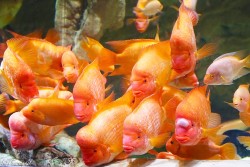Buttikoferi Cichlid (Tilapia buttikoferi) CareSheet

The Buttikoferi Cichlid (Heterotilapia buttikoferi), often known as the Zebra Tilapia, lives in Western African river systems. This fish has a sequence of black and white vertical stripes on its body. Although they might be placid when young, their temperament changes as they become older, becoming quite territorial.
A tank of at least 70 gallons with enough of rocks for territories and a medium-sized gravel filled with hardy plants is good for the Buttikoferi Cichlid. Because this fish may be aggressive against smaller fish, it's best to keep them in a tank with other fish of the same size or in a species tank.
Buttikoferi Cichlids are now being successfully grown in farms and aquariums. They are substrate spawners, digging a trench into which they will deposit their eggs. The couple will become quite hostile during spawning season.
Buttikoferi Cichlids will eat a variety of both meaty and
vegetable-based foods. Brine shrimp, earthworms, and
mosquito larvae are examples of live foods that should be provided. In addition, a
high-quality flake and tablet food with vegetable content should be incorporated in their diet.
Requirements for keeping Zebra Tilapia (Tilapia buttikoferi)
Minimum Tank Size: 70 gallons
Care Level: Easy
Tank Conditions: 72-82°F; pH 7.8-8.5
KH 10-15
Max. Size In Aquarium: Up to 12"
Temperament: Aggressive
Diet: Omnivore

Tilapia buttikoferi community tank
Tilapia buttikoferi species profile
Common names
Tilapia buttikoferi is known by several common names including hornet tilapia, silver tilapia, and black mangrove cichlid.
Etymology
The genus name Tilapia refers to the Tilapiine cichlids. The species name buttikoferi honors Swiss zoologist Johann Büttikofer.
Classification
Tilapia buttikoferi is classified within the Cichlidae family. It belongs to the Tilapia genus of mouth-brooding cichlids.
Distribution
This species is native to coastal regions of West and Central Africa. Its range spans from Senegal to Angola.
Habitat
T. buttikoferi inhabits estuaries, lagoons, and mangrove swamps, especially areas with sandy or muddy substrates.
Maximum Standard Length
In the wild, Tilapia buttikoferi can reach about 60 cm (24 inches). In home aquaria, they are typically around 25-30 cm (10-12 inches).
Aquarium Size
These fish require at least a 250 liter tank given their substantial adult size and schooling nature.
Maintenance
Weekly 25% water changes are recommended along with testing water parameters. Powerful filtration is needed.
Water Conditions
T. buttikoferi do best in brackish water with a pH of 7.0 to 8.0 and temperatures between 22-30 °C (72-86 °F).
Diet
They are omnivorous, accepting flakes, pellets, frozen and live foods including brine shrimp, earthworms, and plant matter.
Behaviour and Compatibility
Generally peaceful schooling fish. Compatible with other brackish African cichlids. Can be kept singly or groups 6+.
Sexual Dimorphism
Males are larger and develop longer dorsal and anal fins. Females display a blotchy dark pattern when breeding.
Reproduction
T. buttikoferi are substrate spawners. Pairs dig a pit in the substrate where the female lays her eggs. The male fertilizes them and both parents guard the eggs and fry.
Endangered List
Tilapia buttikoferi is not considered endangered and has a stable population. It is IUCN Red List Least Concern.
 The Buttikoferi Cichlid (Heterotilapia buttikoferi), often known as the Zebra Tilapia, lives in Western African river systems. This fish has a sequence of black and white vertical stripes on its body. Although they might be placid when young, their temperament changes as they become older, becoming quite territorial.
The Buttikoferi Cichlid (Heterotilapia buttikoferi), often known as the Zebra Tilapia, lives in Western African river systems. This fish has a sequence of black and white vertical stripes on its body. Although they might be placid when young, their temperament changes as they become older, becoming quite territorial.

